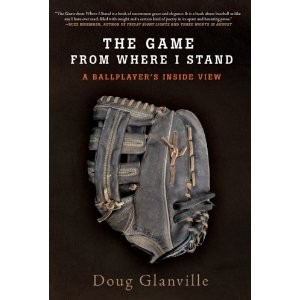Baseball literature changed for good with the publication of Jim Bouton’s Ball Four in 1970. With stories of locker-room rivalry, skirt-chasing, and routine drug use, Bouton took baseball fans to places never explored by the likes of Grantland Rice or Red Smith. Those heroes pictured on our baseball cards became human beings with many — perhaps more — of the frailties we battle in our lives outside the sports arena.

Former big-leaguer Doug Glanville — now a columnist for The New York Times and an analyst for ESPN — has added to the Ball Four genre with The Game From Where I Stand, published by Times Books and scheduled to hit shelves on May 11th. Baseball has evolved in some ways over the last 40 years, devolved in others. Glanville’s book is an illuminating read for those of us who still dream of our first at-bat in the majors, as much for the darker elements of the dream it exposes as for the glamorous details of a big-league life.
Glanville’s bona fides begin with his nine-year career in the majors (1996-2004), when he was a fine center fielder — though never an All-Star – with the Chicago Cubs, Philadelphia Phillies, and Texas Rangers. (Glanville twice scored 100 runs in a season for the Phillies and had 204 hits in 1999.) He also, significantly, is an Ivy League scholar, a graduate of Penn. Glanville was not your average, high-school-phenom-made-good, gawking from behind the batting cage at the long-legged blonde sitting behind the visitors’ dugout (though he has a few stories of juggling romance and a 162-game schedule). To begin with, he was unafraid to ask his coaches questions once he arrived at a big-league training camp. Sometimes questions that didn’t have easy answers. The kind of questions future writers might ask.
“We spend so much time cruising along, looking to hit the straight and dependable fastball, that the audacity of something different can cause us to forget the tactics that once gave us comfort and success.” Glanville manages to eloquently elucidate some baseball-to-life metaphors — like being thrown a curveball — in a style that avoids cliche, but makes a point as worthy of consideration as the old standbys. The book is framed roughly as an allegory for a player’s career: introduction to the game, trials of the minor leagues, success (and failure) in The Show, and the inevitable call of life after baseball.
Glanville never played in a World Series, and he won’t get a vote for the Hall of Fame. Which actually makes his voice close to that of an “everyman,” if a big-league ballplayer could ever be described as such. Instead of the conquering champion we so often read about in memoirs and biographies, Glanville’s tale includes his limitations as a player, in addition to the strengths that got him to the big leagues. “The players with the most internal peace are those who know who they are and, as a result, have found personal success more accessible than the players who chase the illusions of the quantifiable.” Not the consideration of a typical baseball lifer.
Glanville dances along a conflicting line when it comes to this era’s great baseball debate: steroids. Having shunned the use of artificial enhancers, he would have a reasonable case for slinging some mud at those who extended their careers beyond nine years with the help of a syringe. Instead, he takes aim at those who leaked names from the now-infamous Mitchell Report, calling into question the morality of the hunters as much as the hunted. It makes for some provocative reading.
In his novel, Portnoy’s Complaint, Philip Roth wrote, “Oh, to be a center fielder … and nothing more!” A nice sentiment, one Doug Glanville came to realize only in part. Turns out he’s far more than a center fielder.